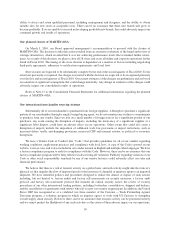American Eagle Outfitters 2009 Annual Report Download - page 21
Download and view the complete annual report
Please find page 21 of the 2009 American Eagle Outfitters annual report below. You can navigate through the pages in the report by either clicking on the pages listed below, or by using the keyword search tool below to find specific information within the annual report.Revenue is recorded net of estimated and actual sales returns and deductions for coupon redemptions and other
promotions. The estimated sales return reserve is based on projected merchandise returns determined through the
use of historical average return percentages. We do not believe there is a reasonable likelihood that there will be a
material change in the future estimates or assumptions we use to calculate our sales return reserve. However, if the
actual rate of sales returns increases significantly, our operating results could be adversely affected.
During Fiscal 2007, we discontinued assessing a service fee on inactive gift cards. As a result, we estimate gift
card breakage and recognize revenue in proportion to actual gift card redemptions as a component of net sales. We
determine an estimated gift card breakage rate by continuously evaluating historical redemption data and the time
when there is a remote likelihood that a gift card will be redeemed.
Merchandise Inventory. Merchandise inventory is valued at the lower of average cost or market, utilizing the
retail method. Average cost includes merchandise design and sourcing costs and related expenses. The Company
records merchandise receipts at the time merchandise is delivered to the foreign shipping port by the manufacturer
(FOB port). This is the point at which title and risk of loss transfer to the Company.
We review our inventory in order to identify slow-moving merchandise and generally use markdowns to clear
merchandise. Additionally, we estimate a markdown reserve for future planned markdowns related to current
inventory. If inventory exceeds customer demand for reasons of style, seasonal adaptation, changes in customer
preference, lack of consumer acceptance of fashion items, competition, or if it is determined that the inventory in
stock will not sell at its currently ticketed price, additional markdowns may be necessary. These markdowns may
have a material adverse impact on earnings, depending on the extent and amount of inventory affected.
We estimate an inventory shrinkage reserve for anticipated losses for the period between the last physical count
and the balance sheet date. The estimate for the shrinkage reserve is calculated based on historical percentages and
can be affected by changes in merchandise mix and changes in actual shrinkage trends. We do not believe there is a
reasonable likelihood that there will be a material change in the future estimates or assumptions we use to calculate
our inventory shrinkage reserve. However, if actual physical inventory losses differ significantly from our estimate,
our operating results could be adversely affected.
Asset Impairment. In accordance with Financial Accounting Standards Board (“FASB”) Accounting Stan-
dard Codification (“ASC”) 360, Property, Plant, and Equipment, we evaluate long-lived assets for impairment
whenever events or changes in circumstances indicate that the carrying value of an asset might not be recoverable.
Assets are evaluated for impairment by comparing the projected undiscounted future cash flows of the asset, over its
remaining useful life, to the carrying value. If the future undiscounted cash flows are projected to be less than the
carrying value of the asset, we adjust the asset value to its estimated fair value and an impairment loss is recorded as
a component of operating income under loss on impairment of assets.
Our impairment loss calculations require management to make assumptions and to apply judgment to estimate
future cash flows and asset fair values, including forecasting useful lives of the assets and selecting the discount rate
that reflects the risk inherent in future cash flows. We do not believe there is a reasonable likelihood that there will
be a material change in the estimates or assumptions we use to calculate long-lived asset impairment losses.
However, if actual results are not consistent with our estimates and assumptions, our operating results could be
adversely affected.
Investment Securities. In accordance with ASC 820, Fair Value Measurements and Disclosures (“ASC 820”),
we measure our investment securities using Level 1, Level 2 and Level 3 inputs. Level 1 and Level 2 inputs are
valued using quoted market prices while we use a discounted cash flow (“DCF”) model to determine the fair value
of our Level 3 investments. The assumptions in our DCF model include different recovery periods depending on the
type of security and varying discount factors for yield and illiquidity. These assumptions are subjective and they are
based on our current judgment and our view of current market conditions. The use of different assumptions would
result in a different valuation and related charge. Future adverse changes in market conditions, continued poor
operating results of underlying investments or other factors could result in further losses that may not be reflected in
an investment’s current carrying value, possibly requiring an additional net impairment loss recognized in earnings
in the future. Any such charge could materially affect our results of operations.
20
























